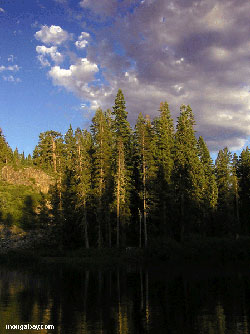Pine plantations may be contributing to global warming
Pine plantations may be contributing to global warming
PINE PLANTATIONS MAY BE ONE CULPRIT IN INCREASING CARBON DIOXIDE LEVELS
By Holly Wagner
Ohio State University
July 24, 2006
The increasing number of pine plantations in the southern United States could contribute to a rise in carbon dioxide levels in the atmosphere, a new study reports.
This is important because carbon dioxide is a key greenhouse gas, one that is linked to global warming.
Landowners in the South are turning stands of hardwood and natural pine trees into pine plantations because pine is a more lucrative source of lumber.
But pine plantations don’t retain carbon as well as hardwood or natural pine forests, said Brent Sohngen, a study co-author and an associate professor of agricultural, environmental and development economics at Ohio State University.

RELATED: United States has 7th highest rate of primary forest loss |
“For environmental reasons, policy makers may want to develop policies that encourage the establishment or maintenance of hardwood forests to ensure diversity across the landscape,” Sohngen said.
Sohngen examined the issues with Sandra Brown, an ecologist with Winrock International, a non-profit organization based in Arlington , Va. Together, the two developed a statistical model, based on the economic value of the land, to predict how many acres of hardwood and natural pine forests would be converted to pine plantations over the next 30 years. They also calculated what this potential conversion would mean in terms of carbon dioxide emissions.
The results appear in a recent issue of the journal Ecological Economics.
The researchers estimate that some 10 million acres — roughly the size of New Hampshire and Vermont — of mainly hardwood and natural pine forests will be chopped down to make way for pine plantations by 2030 in just three Southern states. That translates into roughly 700,000 tons more carbon dioxide released into the atmosphere annually, or 21 million tons over the 30-year period.
That number may seem like a drop in the bucket compared to the 3 billion tons of carbon the United States emits annually. But Sohngen is quick to point out that the model only included Arkansas, Louisiana and Mississippi and that the results can apply across the southern United States, suggesting that carbon dioxide emissions could be as much as four times higher.
The researchers used their model to estimate the proportion of land on which different types of timber were grown. They separated land into three different categories: hardwood stands (including a mix of oak, elm, ash and cottonwood); natural pine stands; and plantations of southern pine species. They also considered the per-hectare rental values for each type of stand (one hectare = 2.5 acres.)
In the last 40 years, roughly 30 million acres (12 million hectares, or about the size of state of Mississippi ) of mostly old and abandoned agricultural lands were converted to pine plantations in Arkansas , Louisiana and Mississippi . But this kind of land has become scarce, and pine plantation owners are now clearing more stands of hardwood trees and natural pines in order to cultivate plantations.
Sohngen and Brown estimate that an area roughly the size of Los Angeles — about 333,600 acres (135,000 hectares) — is converted to pine plantations each year.
Hardwood forests tend to store more carbon than pine plantations do, said Sohngen. And natural pine stands store more carbon than do pine plantations. A hardwood forest has more organic matter — leaves, branches, roots, and a mix of tree species — than a pine plantation does. More organic matter means more storage space for carbon.
Natural pine stands also have more organic matter than a carefully cultivated pine plantation — for instance, a natural pine stand typically has a wider variety of plant and tree species growing in it than a plantation does.
To encourage owners of hardwood and natural pine forests to hold on to their stands, the researchers suggest that existing conservation programs and private transactions for carbon give credit to landowners who maintain or invest in hardwood stands.
“Right now, landowners can make more money from pine than from hardwood stands,” Sohngen said. “Historically, pine plantations are much more productive in terms of timber products.”
Such subsidies would help close the gap with what owners of pine plantations currently earn — about $20 to $50 per acre per year to cultivate their stocks. Owners of hardwood and natural pine stands typically earn less.
“But maintaining hardwood and natural pine forests is an efficient way to store carbon,” he continued. “We can encourage landowners to hold on to these stands — and help reduce carbon dioxide in the atmosphere — by subsidizing their costs.”
Funding from the Electric Power Research Institute to Winrock International supported this study.
This is a modified news release from Ohio State University.